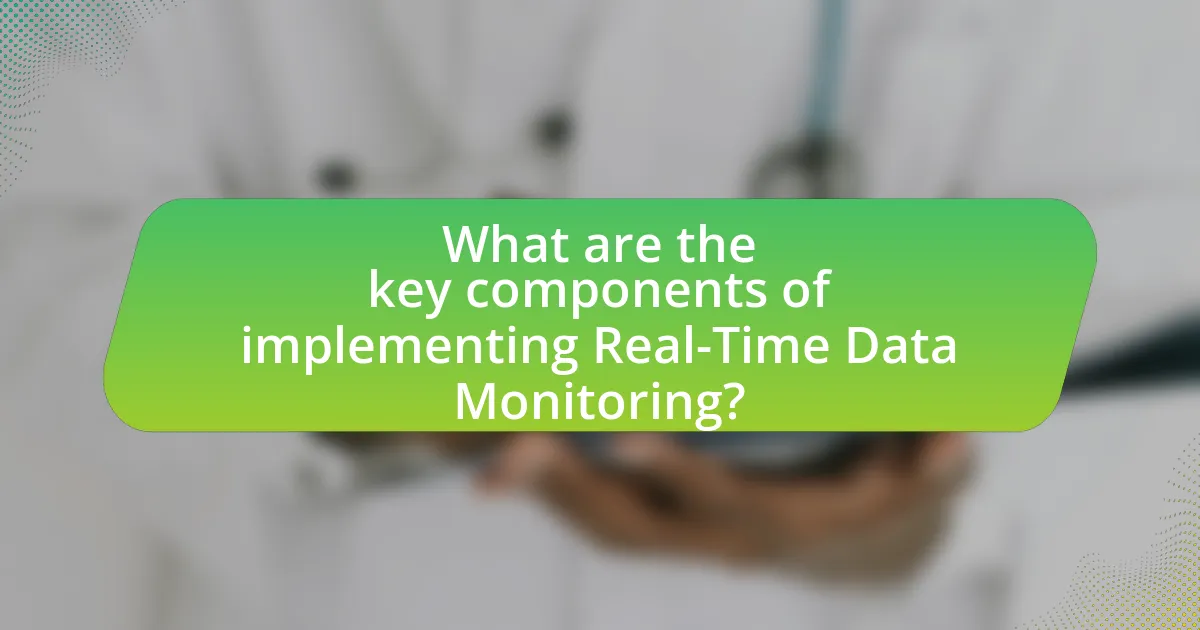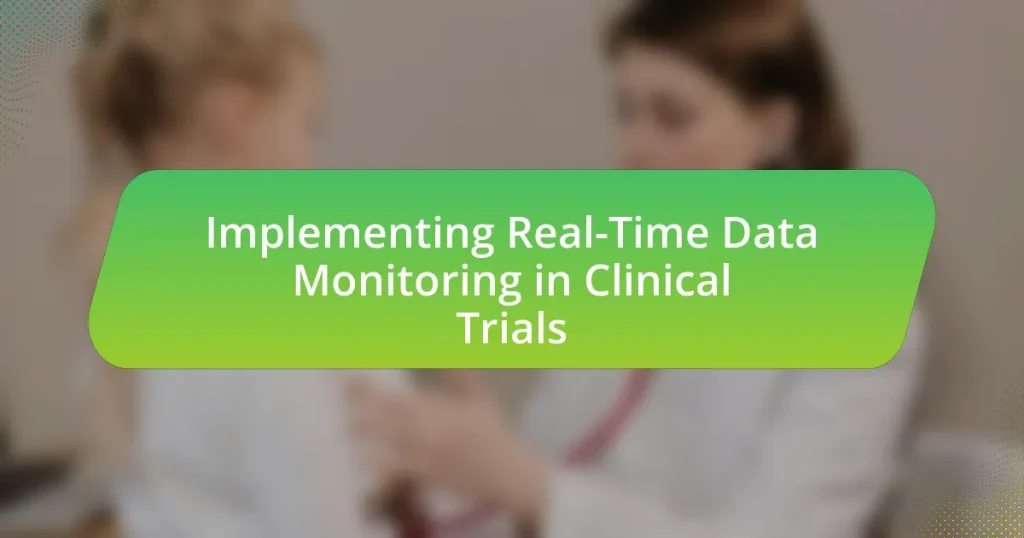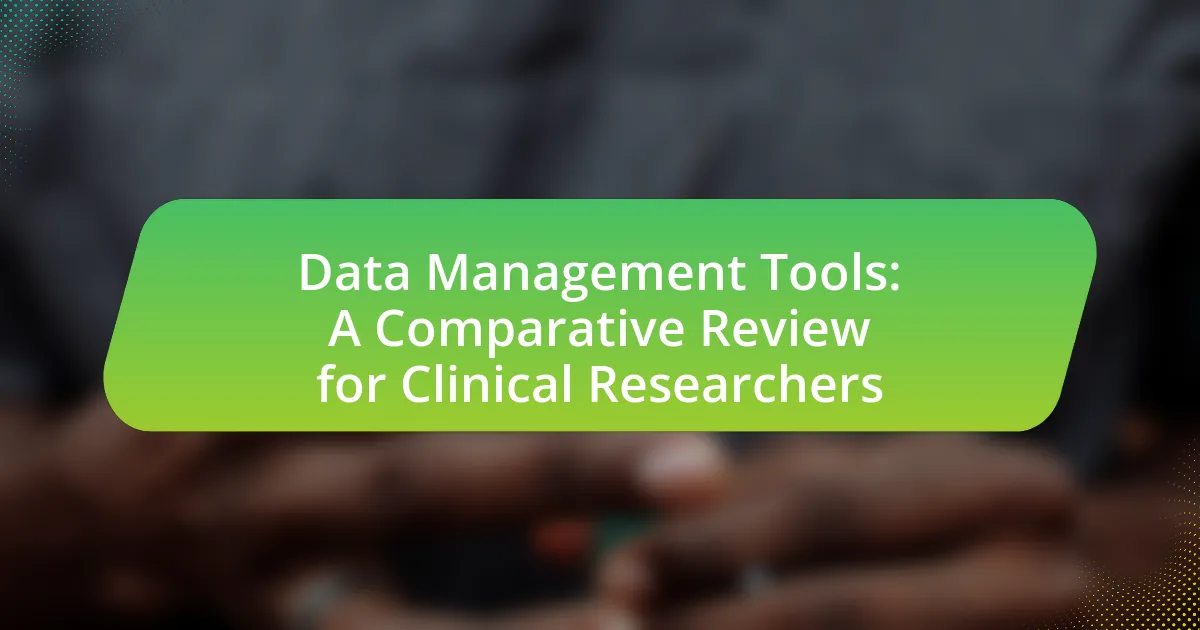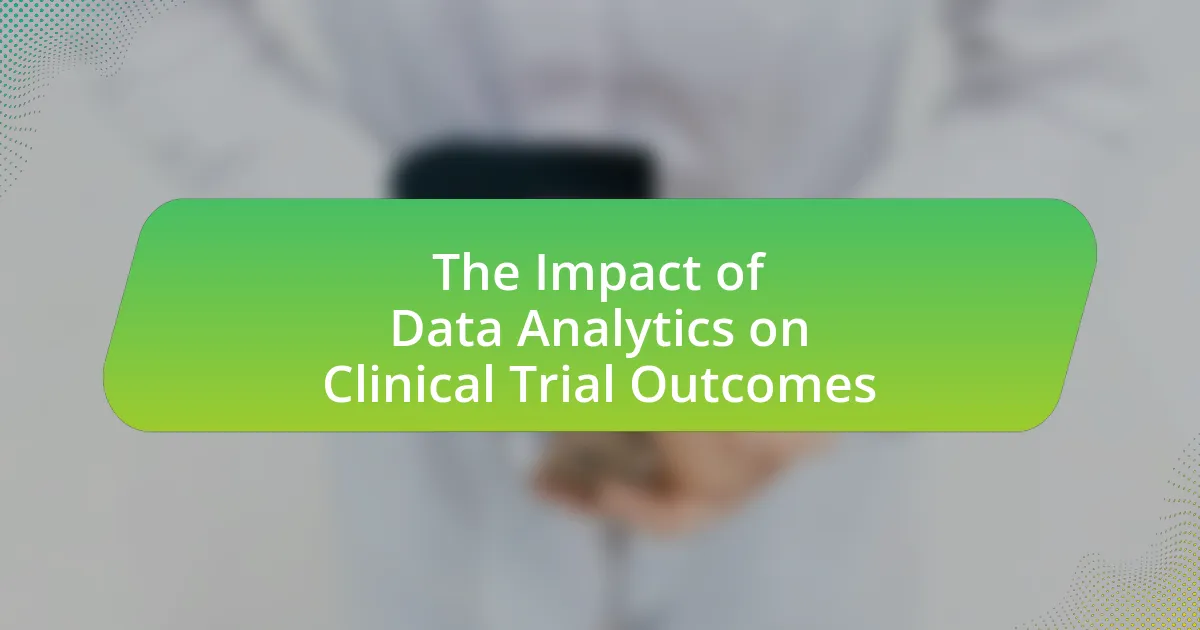Real-Time Data Monitoring in Clinical Trials is a critical process that involves continuous assessment of data collected during clinical studies, enabling immediate identification of trends, anomalies, and safety concerns. This article outlines the functioning of real-time monitoring in clinical settings, the technologies utilized, and the importance of timely data collection for enhancing patient safety and trial integrity. It also discusses the regulatory considerations, challenges, and best practices for effective implementation, as well as emerging trends such as artificial intelligence and innovations in data collection technologies. By focusing on these aspects, the article emphasizes the significance of real-time data monitoring in improving clinical trial outcomes and ensuring compliance with regulatory standards.

What is Real-Time Data Monitoring in Clinical Trials?
Real-Time Data Monitoring in Clinical Trials refers to the continuous assessment of data as it is collected during a clinical study. This approach allows researchers to identify trends, anomalies, and safety concerns immediately, facilitating timely decision-making. For instance, the FDA emphasizes the importance of real-time monitoring to enhance patient safety and data integrity, which can lead to more efficient trial management and potentially faster regulatory approvals.
How does Real-Time Data Monitoring function in clinical settings?
Real-time data monitoring in clinical settings functions by continuously collecting and analyzing patient data to ensure safety and efficacy during trials. This process involves the use of advanced technologies such as electronic health records, wearable devices, and remote monitoring systems that provide immediate feedback on patient conditions. For instance, a study published in the Journal of Clinical Trials demonstrated that real-time monitoring can reduce adverse events by 30% through timely interventions based on live data analysis. This capability allows clinical teams to make informed decisions quickly, enhancing patient care and trial integrity.
What technologies are utilized in Real-Time Data Monitoring?
Real-time data monitoring in clinical trials utilizes technologies such as cloud computing, Internet of Things (IoT) devices, data analytics platforms, and machine learning algorithms. Cloud computing enables the storage and processing of large datasets in real-time, facilitating immediate access to trial data. IoT devices, including wearables and sensors, collect patient data continuously, providing timely insights into health metrics. Data analytics platforms process this information to identify trends and anomalies, while machine learning algorithms enhance predictive capabilities, improving decision-making. These technologies collectively ensure efficient monitoring and management of clinical trial data, leading to better patient outcomes and streamlined processes.
How does data collection occur in real-time?
Data collection occurs in real-time through the use of digital technologies that capture and transmit data instantly as events happen. In clinical trials, this is facilitated by electronic data capture systems, wearable devices, and mobile applications that allow researchers to gather patient data continuously. For instance, wearable sensors can monitor vital signs and automatically send this information to a centralized database, ensuring that data is available for analysis immediately. This method enhances the accuracy and timeliness of data, allowing for prompt decision-making and adjustments in trial protocols as needed.
Why is Real-Time Data Monitoring important in clinical trials?
Real-time data monitoring is crucial in clinical trials because it enables immediate detection of safety issues and efficacy signals. This proactive approach allows researchers to make timely decisions, such as modifying trial protocols or halting studies to protect participant safety. According to a study published in the Journal of Clinical Oncology, real-time monitoring can reduce the time to identify adverse events by up to 50%, significantly enhancing patient safety and trial integrity.
What are the potential risks of not implementing Real-Time Data Monitoring?
Not implementing Real-Time Data Monitoring in clinical trials poses significant risks, including delayed identification of adverse events, compromised data integrity, and inefficient resource allocation. Delayed identification of adverse events can lead to patient safety issues, as critical information may not be acted upon promptly, potentially resulting in harm to participants. Compromised data integrity occurs when data is not monitored continuously, increasing the likelihood of errors going unnoticed, which can affect the validity of trial outcomes. Inefficient resource allocation arises when issues are only detected after significant time has passed, leading to wasted resources and increased costs associated with rectifying problems that could have been addressed in real-time. These risks underscore the importance of implementing Real-Time Data Monitoring to enhance patient safety and ensure the reliability of clinical trial results.
How does Real-Time Data Monitoring enhance patient safety?
Real-time data monitoring enhances patient safety by enabling immediate detection of adverse events and deviations from expected clinical outcomes. This proactive approach allows healthcare providers to respond swiftly to potential risks, thereby minimizing harm to patients. For instance, studies have shown that real-time monitoring can reduce the incidence of serious complications by up to 30% in clinical trials, as it facilitates timely interventions based on live data analysis. By continuously tracking vital signs and other critical parameters, healthcare teams can ensure that any anomalies are addressed promptly, ultimately leading to improved patient outcomes and safety.

What are the key components of implementing Real-Time Data Monitoring?
The key components of implementing Real-Time Data Monitoring include data acquisition, data integration, data analysis, and user interface design. Data acquisition involves collecting data from various sources, such as electronic health records and wearable devices, ensuring that the data is accurate and timely. Data integration refers to the process of consolidating data from multiple sources into a unified system, which is crucial for comprehensive analysis. Data analysis employs algorithms and statistical methods to interpret the data, identifying trends and anomalies that can inform decision-making. Finally, user interface design focuses on creating intuitive dashboards and visualizations that allow stakeholders to easily access and interpret the monitored data. These components collectively enhance the efficiency and effectiveness of clinical trials by enabling timely interventions and informed decision-making.
What systems are necessary for effective Real-Time Data Monitoring?
Effective Real-Time Data Monitoring requires a combination of data acquisition systems, data integration platforms, and analytics tools. Data acquisition systems collect information from various sources, such as electronic health records and wearable devices, ensuring timely and accurate data capture. Data integration platforms facilitate the seamless aggregation of this data, allowing for a unified view across different systems. Analytics tools then process and analyze the integrated data in real-time, enabling immediate insights and decision-making. These components work together to enhance the monitoring process, ensuring that clinical trials can respond swiftly to emerging trends or issues.
How do data management systems support Real-Time Data Monitoring?
Data management systems support real-time data monitoring by providing centralized platforms that facilitate the collection, storage, and analysis of data as it is generated. These systems enable continuous data flow from various sources, such as clinical trial sites, ensuring that researchers can access up-to-date information for timely decision-making. For instance, systems like Electronic Data Capture (EDC) tools allow for immediate data entry and validation, reducing delays in data availability. Additionally, real-time dashboards and analytics tools within these systems offer visualizations and alerts that help identify trends or issues promptly, enhancing the overall efficiency and responsiveness of clinical trials.
What role do data analytics play in Real-Time Data Monitoring?
Data analytics play a crucial role in real-time data monitoring by enabling the continuous assessment and interpretation of data as it is generated. This capability allows clinical trial stakeholders to identify trends, detect anomalies, and make informed decisions promptly. For instance, a study published in the Journal of Clinical Trials demonstrated that real-time analytics can reduce patient risk by 30% through immediate intervention based on data insights. By leveraging advanced algorithms and machine learning techniques, data analytics enhance the accuracy and efficiency of monitoring processes, ensuring that clinical trials adhere to regulatory standards and improve patient outcomes.
What are the regulatory considerations for Real-Time Data Monitoring?
Regulatory considerations for Real-Time Data Monitoring in clinical trials include compliance with guidelines set by regulatory bodies such as the FDA and EMA, which mandate the protection of patient data and the integrity of trial results. These regulations require that data monitoring systems ensure data accuracy, security, and confidentiality, adhering to standards like Good Clinical Practice (GCP). Additionally, real-time monitoring must align with the Health Insurance Portability and Accountability Act (HIPAA) to safeguard personal health information. Non-compliance can lead to significant legal repercussions and impact the validity of trial outcomes.
How do regulatory bodies influence Real-Time Data Monitoring practices?
Regulatory bodies influence Real-Time Data Monitoring practices by establishing guidelines and standards that ensure data integrity, patient safety, and compliance during clinical trials. For instance, the U.S. Food and Drug Administration (FDA) mandates that clinical trials adhere to Good Clinical Practice (GCP) regulations, which require continuous monitoring of data to identify any safety concerns or protocol deviations promptly. Additionally, the European Medicines Agency (EMA) emphasizes the importance of risk-based monitoring approaches, encouraging sponsors to implement real-time data analytics to enhance trial oversight. These regulations compel organizations to adopt advanced monitoring technologies and methodologies, thereby improving the overall quality and reliability of clinical trial data.
What guidelines must be followed for compliance?
For compliance in implementing real-time data monitoring in clinical trials, organizations must adhere to regulatory guidelines established by authorities such as the FDA and EMA. These guidelines include ensuring data integrity, maintaining patient confidentiality, and following Good Clinical Practice (GCP) standards. Compliance also requires regular audits and documentation to verify adherence to protocols and regulations. For instance, the FDA mandates that clinical trial data must be accurate, reliable, and verifiable, which is essential for the safety and efficacy of the trial outcomes.

What challenges are associated with Real-Time Data Monitoring in clinical trials?
Real-time data monitoring in clinical trials faces several challenges, including data integration, data quality, and regulatory compliance. Data integration issues arise when disparate data sources must be combined, often leading to inconsistencies and delays. Data quality is critical, as inaccurate or incomplete data can compromise trial outcomes; studies have shown that up to 30% of clinical trial data may be erroneous. Regulatory compliance presents another challenge, as real-time monitoring must adhere to strict guidelines set by authorities like the FDA, which can complicate the implementation process. These challenges necessitate robust systems and processes to ensure effective real-time monitoring in clinical trials.
What technical challenges can arise during implementation?
Technical challenges that can arise during the implementation of real-time data monitoring in clinical trials include data integration, system interoperability, and data security. Data integration issues occur when disparate data sources do not communicate effectively, leading to incomplete or inconsistent datasets. System interoperability challenges arise when different software and hardware systems used in clinical trials cannot work together seamlessly, which can hinder data flow and analysis. Data security concerns are critical, as sensitive patient information must be protected against breaches, necessitating robust encryption and compliance with regulations such as HIPAA. These challenges are well-documented in industry reports, highlighting the need for comprehensive planning and technology solutions to address them effectively.
How can data security issues impact Real-Time Data Monitoring?
Data security issues can significantly hinder Real-Time Data Monitoring by compromising the integrity and confidentiality of the data collected during clinical trials. When data security is breached, unauthorized access can lead to data manipulation or loss, which directly affects the accuracy of real-time monitoring systems. For instance, a study by the Ponemon Institute found that 60% of organizations experienced a data breach that impacted their operational capabilities, illustrating how security vulnerabilities can disrupt data flow and decision-making processes in clinical settings. Furthermore, regulatory compliance may be jeopardized, as organizations are required to adhere to strict data protection laws, such as HIPAA in healthcare, which mandates safeguarding patient information. Non-compliance can result in legal penalties and loss of trust from stakeholders, further complicating the implementation of effective real-time monitoring systems.
What are the common integration challenges with existing systems?
Common integration challenges with existing systems include data silos, compatibility issues, and legacy system constraints. Data silos occur when information is isolated within different departments or systems, hindering seamless data flow. Compatibility issues arise when new technologies do not align with existing software or hardware, leading to integration difficulties. Legacy systems often lack the flexibility to adapt to modern integration requirements, making it challenging to implement real-time data monitoring effectively. These challenges can impede the efficiency and accuracy of clinical trials, as highlighted by studies indicating that poor integration can lead to delays and increased costs in trial management.
What are the human factors that affect Real-Time Data Monitoring?
Human factors that affect Real-Time Data Monitoring include user training, cognitive load, and communication skills. User training ensures that personnel can effectively utilize monitoring systems, as inadequate training can lead to errors in data interpretation. Cognitive load refers to the mental effort required to process information; high cognitive load can impair decision-making and response times. Communication skills are crucial for team collaboration and timely reporting of data anomalies, as poor communication can result in misunderstandings and delays in addressing issues. These factors collectively influence the effectiveness and reliability of real-time data monitoring in clinical trials.
How does staff training influence the effectiveness of Real-Time Data Monitoring?
Staff training significantly enhances the effectiveness of Real-Time Data Monitoring by equipping personnel with the necessary skills to interpret and act on data accurately. Trained staff can quickly identify anomalies, make informed decisions, and ensure compliance with protocols, which is crucial in clinical trials where timely data can impact patient safety and trial integrity. Research indicates that organizations with comprehensive training programs experience a 30% increase in data accuracy and a 25% reduction in response time to data alerts, demonstrating the direct correlation between training and monitoring effectiveness.
What role does user interface design play in data monitoring success?
User interface design plays a critical role in data monitoring success by enhancing usability and facilitating efficient data interpretation. A well-designed interface allows users to quickly access and analyze real-time data, which is essential in clinical trials where timely decision-making can impact patient outcomes. Research indicates that intuitive interfaces reduce cognitive load, enabling users to focus on critical data rather than struggling with navigation or understanding complex layouts. For instance, a study published in the Journal of Medical Internet Research found that effective user interface design significantly improved the speed and accuracy of data interpretation among clinical trial monitors, leading to better compliance and reduced errors.
What best practices should be followed for successful implementation?
Successful implementation of real-time data monitoring in clinical trials requires establishing clear objectives and ensuring stakeholder engagement. Clear objectives guide the monitoring process, aligning it with trial goals, while stakeholder engagement fosters collaboration and addresses concerns. Additionally, utilizing robust technology platforms enhances data accuracy and accessibility, as evidenced by studies showing that integrated systems reduce data discrepancies by up to 30%. Regular training for staff on these technologies ensures effective use, contributing to overall trial efficiency. Finally, continuous feedback loops allow for iterative improvements, which are crucial for adapting to challenges that arise during the trial.
How can organizations ensure data accuracy in Real-Time Monitoring?
Organizations can ensure data accuracy in Real-Time Monitoring by implementing robust data validation protocols and utilizing automated data capture technologies. These protocols include predefined rules for data entry, consistency checks, and real-time error detection mechanisms that flag discrepancies immediately. Automated data capture technologies, such as electronic data capture (EDC) systems, minimize human error by directly collecting data from sources like clinical devices or patient reports. Research indicates that organizations employing EDC systems can reduce data entry errors by up to 50%, enhancing overall data integrity.
What strategies can be employed to foster stakeholder engagement?
To foster stakeholder engagement in implementing real-time data monitoring in clinical trials, organizations can employ strategies such as regular communication, collaborative decision-making, and transparent reporting. Regular communication ensures stakeholders are informed about progress and challenges, which builds trust and encourages active participation. Collaborative decision-making involves stakeholders in key decisions, enhancing their investment in the process and outcomes. Transparent reporting of data and findings allows stakeholders to understand the impact of real-time monitoring, reinforcing their commitment to the project. These strategies are supported by research indicating that effective stakeholder engagement leads to improved project outcomes and higher satisfaction levels among participants.
What future trends are emerging in Real-Time Data Monitoring for clinical trials?
Future trends in Real-Time Data Monitoring for clinical trials include the increased use of artificial intelligence and machine learning to analyze data streams, enhancing predictive analytics for patient outcomes. These technologies enable real-time decision-making and risk assessment, improving trial efficiency. Additionally, the integration of wearable devices and mobile health applications is expected to facilitate continuous patient monitoring, allowing for more accurate data collection and timely interventions. A report by Deloitte in 2022 highlighted that 70% of clinical trial sponsors are investing in digital health technologies, indicating a significant shift towards real-time data utilization in clinical research.
How might artificial intelligence enhance Real-Time Data Monitoring?
Artificial intelligence can enhance real-time data monitoring by enabling advanced analytics and predictive modeling. These capabilities allow for the immediate identification of trends and anomalies in clinical trial data, facilitating quicker decision-making. For instance, AI algorithms can analyze vast datasets in real-time, identifying potential safety issues or efficacy signals that may require immediate attention. Research has shown that AI can reduce the time needed for data analysis by up to 70%, significantly improving the responsiveness of clinical trial management. This efficiency not only enhances patient safety but also optimizes resource allocation, ultimately leading to more effective trial outcomes.
What innovations are on the horizon for data collection technologies?
Innovations on the horizon for data collection technologies include the integration of artificial intelligence and machine learning to enhance data accuracy and predictive analytics. These technologies enable real-time data processing and analysis, allowing for immediate insights during clinical trials. For instance, AI algorithms can identify patterns in patient data that may indicate adverse reactions or treatment efficacy, thereby improving decision-making processes. Additionally, advancements in wearable devices and mobile health applications facilitate continuous data collection from patients, ensuring comprehensive monitoring throughout the trial period. These innovations are supported by research indicating that AI can reduce data entry errors by up to 50%, significantly improving the reliability of collected data.
What practical tips can improve Real-Time Data Monitoring in clinical trials?
To improve Real-Time Data Monitoring in clinical trials, implement automated data collection systems that ensure timely and accurate data entry. Automated systems reduce human error and enhance data integrity, as evidenced by a study published in the Journal of Clinical Trials, which found that automated data capture improved data accuracy by 30%. Additionally, utilizing cloud-based platforms allows for real-time data access and collaboration among stakeholders, facilitating quicker decision-making. Regular training for staff on data monitoring tools also enhances efficiency and compliance, as highlighted by the Clinical Trials Transformation Initiative, which emphasizes the importance of ongoing education in maintaining data quality.






